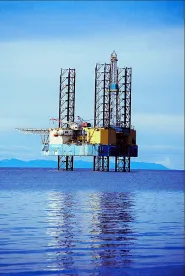In a recent Notice of Inquiry, the Federal Communications Commission (FCC or Commission) signaled that it may free up radio spectrum for offshore broadband networks and connectivity to land-based systems to support next generation energy sector uses. The Commission is seeking comment on potential updates to its rules regarding spectrum access for both private and commercial networks to increase communications availability for both offshore windfarms and oil rigs, as well as other offshore infrastructure. Comments are due July 27, 2022, and reply comments are due on August 26, 2022.
Background
Currently, in the energy sector, offshore spectrum is being used to support offshore oil drilling, and primarily involves geographic-based licensing limited to the Gulf of Mexico. In addition, the FCC uses a site-based demand driven paradigm in many spectrum bands to provide for narrowband spectrum access in the Gulf of Mexico and in other U.S. territorial waters in the Atlantic and Pacific Oceans, including areas adjacent to the Continental U.S., Alaska, Hawaii, Puerto Rico, the U.S. Virgin Islands, American Samoa, Guam, and the Northern Mariana Islands. The majority of site-based offshore authorizations are for Private Land Mobile Radio services, radiolocation services, aviation-ground services, and maritime coast stations. The FCC notes that there are more than 1,400 active site-based licenses issued offshore across many different radio services. The FCC’s rules also provide for unlicensed operation and experimental radio use offshore, and offshore energy platforms rely on a variety of technical options for communications including satellite, microwave, fiber optic submarine cables, and cellular.
The Notice is the first step toward facilitating offshore operations through innovative spectrum management policies. Through the Notice, the FCC is seeking to develop a record and understand potential offshore operation uses that require spectrum, to determine whether rule and policy changes are needed to facilitate the development of offshore commercial and private networks, with a particular emphasis on offshore energy projects.
Comments Sought
In its Notice, in addition to oil rigs, the Commission focuses on the spectrum needs of the renewable energy sector, and in particular, offshore windfarms. Robust wireless connections for these offshore energy platforms would allow for the creation of broadband networks connecting offshore facilities, such as multiple wind turbines or drilling platforms, as well as between offshore facilities and land-based locations.1 The FCC anticipates that windfarms in the Atlantic and Pacific oceans, and potentially beyond, may need spectrum for wireless services to the site during construction of the windfarm, and for testing, daily operation, and emergency maintenance, among other uses. To assist in development of the record, the Commission seeks comment on particular windfarm wireless use cases, and questions whether current spectrum availability and licensing is deficient.
The FCC also seeks comment on other needs or uses for offshore spectrum. Specifically, the FCC seeks comment on the demand for offshore spectrum, where the demand is concentrated, and what spectrum licensing models might meet this demand. The FCC wants to understand the extent of demand for offshore spectrum, how much spectrum would meet the demand, and how it might allocate spectrum. With regard to spectrum allocation, the FCC seeks comment on the potential use of models such as unlicensed use, spectrum leasing, shared spectrum rights, or secondary operation authorizations, to meet offshore spectrum needs, and the specific spectrum bands that may facilitate offshore operations.
The FCC also seeks comment on the infrastructure needed to support offshore spectrum operations. Specifically, the FCC questions the infrastructure needed to support base stations, end-user equipment, fixed transmitters, beacons, and other equipment offshore, and whether such infrastructure will be fixed/stationary, drifting in the water, airborne, or deployed in another way.
Differing Commissioner Policy Views
In the FCC June Open Meeting adopting the Notice, the differing policy views between Commission Democrats and Republicans over renewable versus carbon-based energy sources was evident. For example, Republican Commissioner Brendan Carr quipped, “It's got a bit of a convoluted name – ‘Facilitating Access to Spectrum for Offshore Uses and Operations.’ I tried to propose the shorthand of the ‘Drill, Baby, Drill NOI,’ but we did not have unanimous consent for making that change.”
In contrast, Commission Democrats, who are squarely aligning themselves with Biden Administration initiatives to spur offshore wind deployment as part of its broader clean energy economy agenda, were focused on the needs of the offshore renewable energy sector, and opportunities the Notice presented for aiding the construction and operations of windfarms in both the Atlantic and Pacific Oceans.
“I support this Notice of Inquiry because it takes an important step toward ensuring that our rules work for a clean energy economy,” Commissioner Geoffrey Starks said in a statement. “By 2030, the federal government is targeting at least 30 gigawatts in offshore wind capacity, more than one thousand times 2019 deployments yet still a small fraction of our total potential. […] Real scale is on the horizon, and each project will rely on wireless in one form or another.”
Chairwoman Jessica Rosenworcel, also a Democrat, similarly noted in her separate statement, that questions in the Notice are focused on “the kind of offshore operations that may require access to airwaves, the right combination of spectrum bands for these uses, and creative licensed and unlicensed ideas for assigning these rights.” This, in practice, the Chairwoman noted, “can help the development of offshore windfarms that can harness wind over water and covert it to renewable electricity.”
ENDNOTES
1 As an example, one manufacturer touts its windfarm private wireless communications solution as providing mission-critical reliability and low-latency, broadband connectivity for connecting workers, sensors, cameras, and turbines.





 />i
/>i

